Community Health in Inala: Social Determinants, Needs, & Interventions
VerifiedAdded on 2022/08/13
|9
|2069
|20
Report
AI Summary
This report assesses the community health of Inala, focusing on the impact of social determinants such as education, employment, and income on health outcomes. It highlights that Inala has a lower rate of higher education, full-time employment, and median personal weekly income compared to Queensland and national averages, contributing to lower health literacy and access. The report identifies the elderly population as a vulnerable group and type 2 diabetes as a major health issue, often accompanied by co-morbidities. To address these challenges, the report proposes health promotion interventions centered on improving health literacy through education programs and advocating for subsidized healthcare policies to enhance access for vulnerable populations. The conclusion emphasizes the need for a comprehensive approach involving both education and policy development to improve the overall health condition of the Inala community.
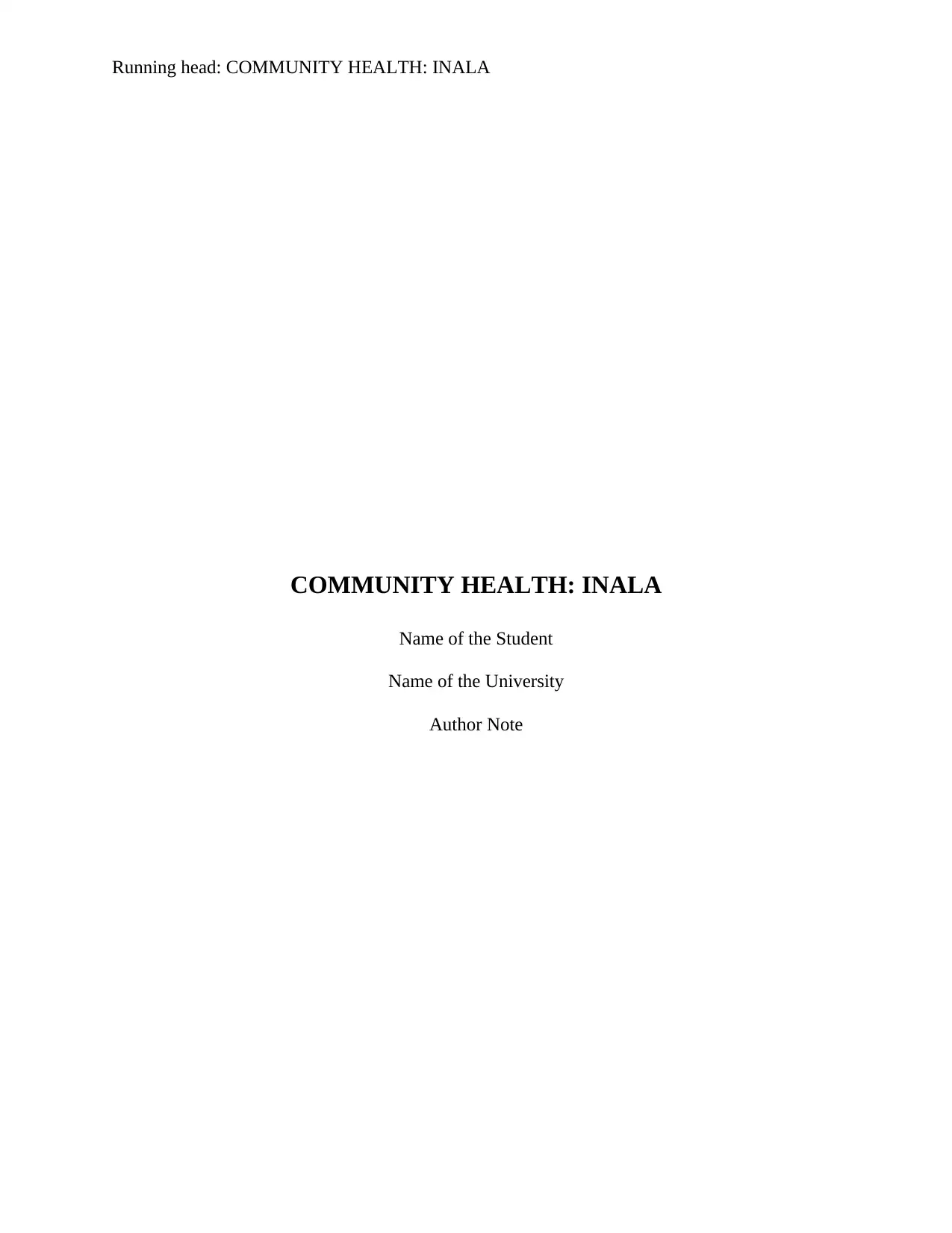
Running head: COMMUNITY HEALTH: INALA
COMMUNITY HEALTH: INALA
Name of the Student
Name of the University
Author Note
COMMUNITY HEALTH: INALA
Name of the Student
Name of the University
Author Note
Paraphrase This Document
Need a fresh take? Get an instant paraphrase of this document with our AI Paraphraser

1
COMMUNITY HEALTH: INALA
PART A
Table 1: Comparison of Inala community, Queensland state and National population data
A. Category of Data (Inala
community)
B. Summary and
Comparative Statement
C. Inference Statement
Highest education
12.3 per cent of the population has
a degree
(Quickstats.censusdata.abs.gov.au.,
2020).
12.3 per cent of the
population of Inala
community has a degree
course. On the other hand,
Queensland state and
Australian population
degree course rate are 18.3
and 22 per cent
respectively.
The comparison data
showed that the level of
education is lower among
Inala population which
can be accounted for lower
health literacy.
Full time employment rate 55.8
per cent
(Quickstats.censusdata.abs.gov.au.,
2020).
55.8 per cent people have
full time employment in
Inala community whereas,
57.7 per cent employment
rate has been found among
Queensland state and
Australian population.
The comparison showed
that the community
employment rate is lower
than state and national
population.
Median Personal Weekly Income
$535
(Quickstats.censusdata.abs.gov.au.,
2020).
$535 is the median weekly
personal income of Inala
community people.
Queensland state
population and Australian
population weekly median
personal income are $660
and $662 respectively.
The comparison showed
that the community
income rate is lower than
state and national
population which can be
marked as negative factor
health access and literacy
development.
COMMUNITY HEALTH: INALA
PART A
Table 1: Comparison of Inala community, Queensland state and National population data
A. Category of Data (Inala
community)
B. Summary and
Comparative Statement
C. Inference Statement
Highest education
12.3 per cent of the population has
a degree
(Quickstats.censusdata.abs.gov.au.,
2020).
12.3 per cent of the
population of Inala
community has a degree
course. On the other hand,
Queensland state and
Australian population
degree course rate are 18.3
and 22 per cent
respectively.
The comparison data
showed that the level of
education is lower among
Inala population which
can be accounted for lower
health literacy.
Full time employment rate 55.8
per cent
(Quickstats.censusdata.abs.gov.au.,
2020).
55.8 per cent people have
full time employment in
Inala community whereas,
57.7 per cent employment
rate has been found among
Queensland state and
Australian population.
The comparison showed
that the community
employment rate is lower
than state and national
population.
Median Personal Weekly Income
$535
(Quickstats.censusdata.abs.gov.au.,
2020).
$535 is the median weekly
personal income of Inala
community people.
Queensland state
population and Australian
population weekly median
personal income are $660
and $662 respectively.
The comparison showed
that the community
income rate is lower than
state and national
population which can be
marked as negative factor
health access and literacy
development.
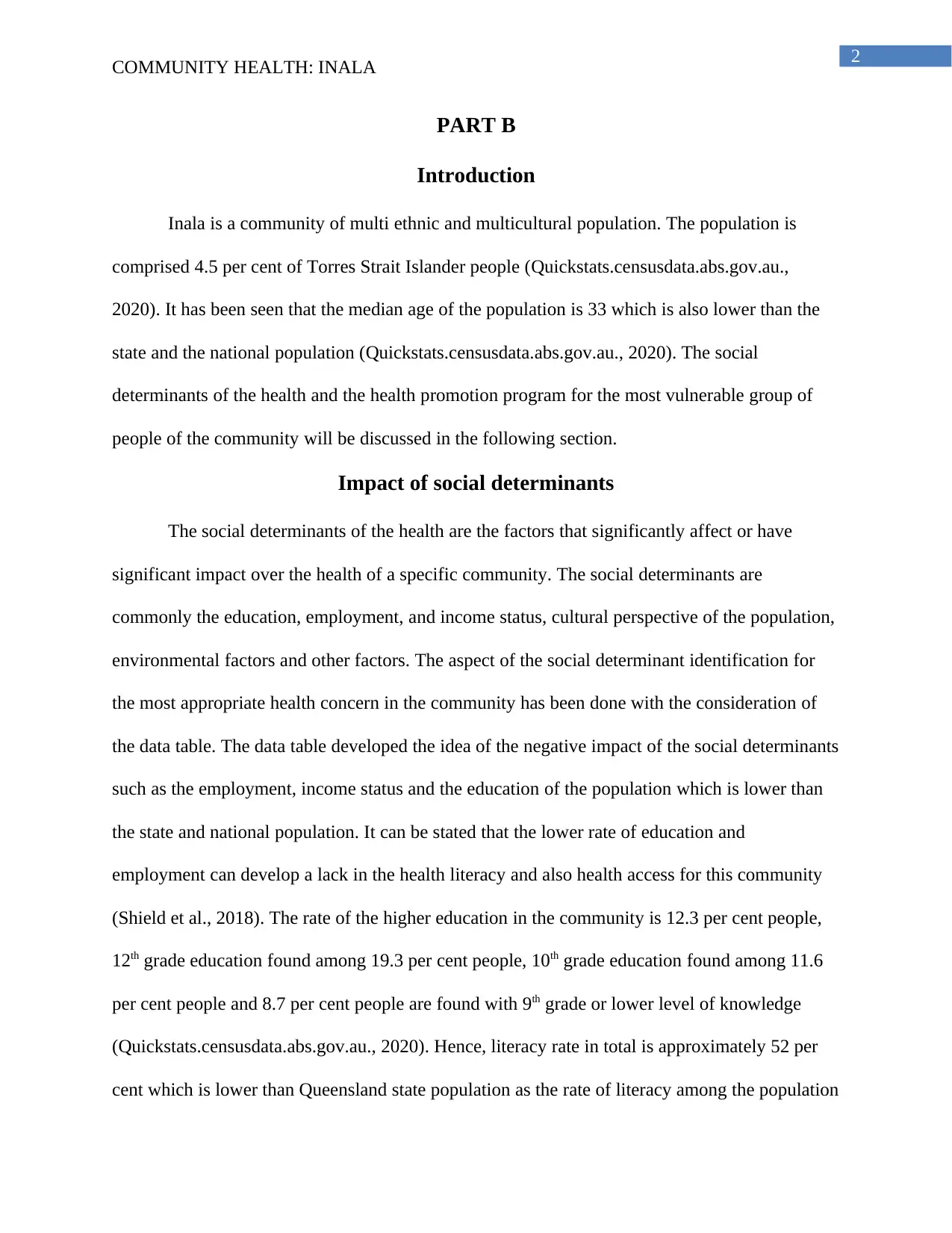
2
COMMUNITY HEALTH: INALA
PART B
Introduction
Inala is a community of multi ethnic and multicultural population. The population is
comprised 4.5 per cent of Torres Strait Islander people (Quickstats.censusdata.abs.gov.au.,
2020). It has been seen that the median age of the population is 33 which is also lower than the
state and the national population (Quickstats.censusdata.abs.gov.au., 2020). The social
determinants of the health and the health promotion program for the most vulnerable group of
people of the community will be discussed in the following section.
Impact of social determinants
The social determinants of the health are the factors that significantly affect or have
significant impact over the health of a specific community. The social determinants are
commonly the education, employment, and income status, cultural perspective of the population,
environmental factors and other factors. The aspect of the social determinant identification for
the most appropriate health concern in the community has been done with the consideration of
the data table. The data table developed the idea of the negative impact of the social determinants
such as the employment, income status and the education of the population which is lower than
the state and national population. It can be stated that the lower rate of education and
employment can develop a lack in the health literacy and also health access for this community
(Shield et al., 2018). The rate of the higher education in the community is 12.3 per cent people,
12th grade education found among 19.3 per cent people, 10th grade education found among 11.6
per cent people and 8.7 per cent people are found with 9th grade or lower level of knowledge
(Quickstats.censusdata.abs.gov.au., 2020). Hence, literacy rate in total is approximately 52 per
cent which is lower than Queensland state population as the rate of literacy among the population
COMMUNITY HEALTH: INALA
PART B
Introduction
Inala is a community of multi ethnic and multicultural population. The population is
comprised 4.5 per cent of Torres Strait Islander people (Quickstats.censusdata.abs.gov.au.,
2020). It has been seen that the median age of the population is 33 which is also lower than the
state and the national population (Quickstats.censusdata.abs.gov.au., 2020). The social
determinants of the health and the health promotion program for the most vulnerable group of
people of the community will be discussed in the following section.
Impact of social determinants
The social determinants of the health are the factors that significantly affect or have
significant impact over the health of a specific community. The social determinants are
commonly the education, employment, and income status, cultural perspective of the population,
environmental factors and other factors. The aspect of the social determinant identification for
the most appropriate health concern in the community has been done with the consideration of
the data table. The data table developed the idea of the negative impact of the social determinants
such as the employment, income status and the education of the population which is lower than
the state and national population. It can be stated that the lower rate of education and
employment can develop a lack in the health literacy and also health access for this community
(Shield et al., 2018). The rate of the higher education in the community is 12.3 per cent people,
12th grade education found among 19.3 per cent people, 10th grade education found among 11.6
per cent people and 8.7 per cent people are found with 9th grade or lower level of knowledge
(Quickstats.censusdata.abs.gov.au., 2020). Hence, literacy rate in total is approximately 52 per
cent which is lower than Queensland state population as the rate of literacy among the population
⊘ This is a preview!⊘
Do you want full access?
Subscribe today to unlock all pages.

Trusted by 1+ million students worldwide
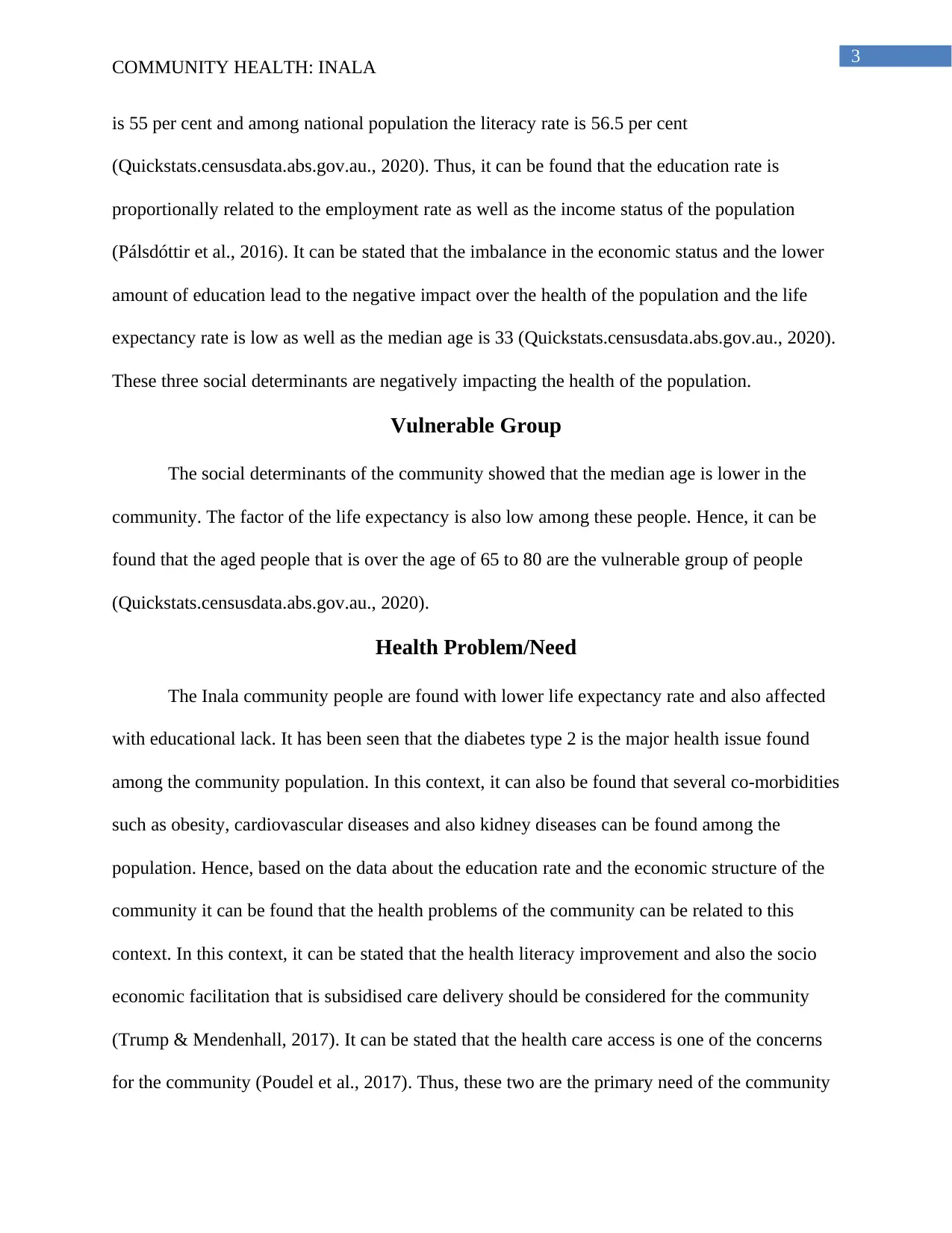
3
COMMUNITY HEALTH: INALA
is 55 per cent and among national population the literacy rate is 56.5 per cent
(Quickstats.censusdata.abs.gov.au., 2020). Thus, it can be found that the education rate is
proportionally related to the employment rate as well as the income status of the population
(Pálsdóttir et al., 2016). It can be stated that the imbalance in the economic status and the lower
amount of education lead to the negative impact over the health of the population and the life
expectancy rate is low as well as the median age is 33 (Quickstats.censusdata.abs.gov.au., 2020).
These three social determinants are negatively impacting the health of the population.
Vulnerable Group
The social determinants of the community showed that the median age is lower in the
community. The factor of the life expectancy is also low among these people. Hence, it can be
found that the aged people that is over the age of 65 to 80 are the vulnerable group of people
(Quickstats.censusdata.abs.gov.au., 2020).
Health Problem/Need
The Inala community people are found with lower life expectancy rate and also affected
with educational lack. It has been seen that the diabetes type 2 is the major health issue found
among the community population. In this context, it can also be found that several co-morbidities
such as obesity, cardiovascular diseases and also kidney diseases can be found among the
population. Hence, based on the data about the education rate and the economic structure of the
community it can be found that the health problems of the community can be related to this
context. In this context, it can be stated that the health literacy improvement and also the socio
economic facilitation that is subsidised care delivery should be considered for the community
(Trump & Mendenhall, 2017). It can be stated that the health care access is one of the concerns
for the community (Poudel et al., 2017). Thus, these two are the primary need of the community
COMMUNITY HEALTH: INALA
is 55 per cent and among national population the literacy rate is 56.5 per cent
(Quickstats.censusdata.abs.gov.au., 2020). Thus, it can be found that the education rate is
proportionally related to the employment rate as well as the income status of the population
(Pálsdóttir et al., 2016). It can be stated that the imbalance in the economic status and the lower
amount of education lead to the negative impact over the health of the population and the life
expectancy rate is low as well as the median age is 33 (Quickstats.censusdata.abs.gov.au., 2020).
These three social determinants are negatively impacting the health of the population.
Vulnerable Group
The social determinants of the community showed that the median age is lower in the
community. The factor of the life expectancy is also low among these people. Hence, it can be
found that the aged people that is over the age of 65 to 80 are the vulnerable group of people
(Quickstats.censusdata.abs.gov.au., 2020).
Health Problem/Need
The Inala community people are found with lower life expectancy rate and also affected
with educational lack. It has been seen that the diabetes type 2 is the major health issue found
among the community population. In this context, it can also be found that several co-morbidities
such as obesity, cardiovascular diseases and also kidney diseases can be found among the
population. Hence, based on the data about the education rate and the economic structure of the
community it can be found that the health problems of the community can be related to this
context. In this context, it can be stated that the health literacy improvement and also the socio
economic facilitation that is subsidised care delivery should be considered for the community
(Trump & Mendenhall, 2017). It can be stated that the health care access is one of the concerns
for the community (Poudel et al., 2017). Thus, these two are the primary need of the community
Paraphrase This Document
Need a fresh take? Get an instant paraphrase of this document with our AI Paraphraser
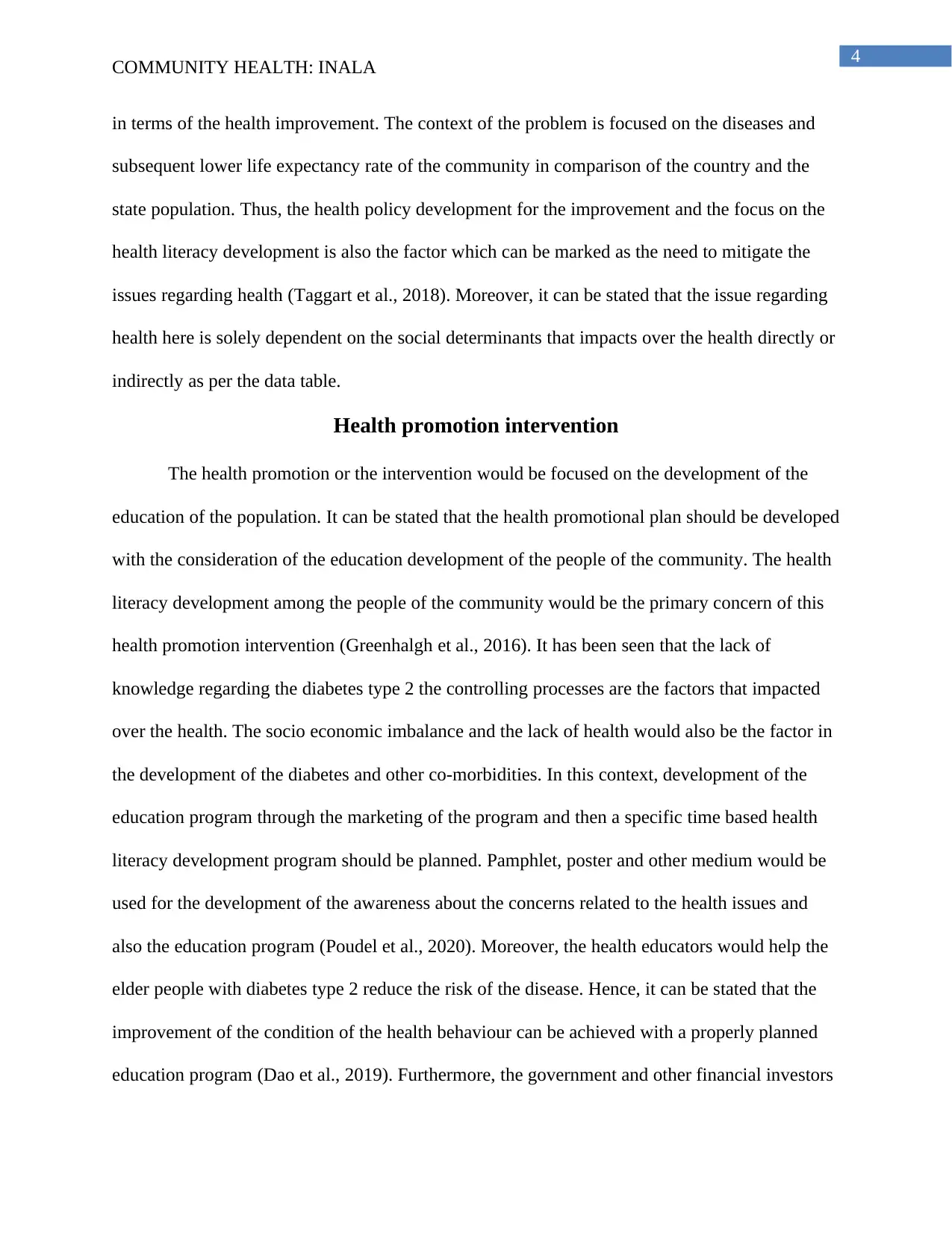
4
COMMUNITY HEALTH: INALA
in terms of the health improvement. The context of the problem is focused on the diseases and
subsequent lower life expectancy rate of the community in comparison of the country and the
state population. Thus, the health policy development for the improvement and the focus on the
health literacy development is also the factor which can be marked as the need to mitigate the
issues regarding health (Taggart et al., 2018). Moreover, it can be stated that the issue regarding
health here is solely dependent on the social determinants that impacts over the health directly or
indirectly as per the data table.
Health promotion intervention
The health promotion or the intervention would be focused on the development of the
education of the population. It can be stated that the health promotional plan should be developed
with the consideration of the education development of the people of the community. The health
literacy development among the people of the community would be the primary concern of this
health promotion intervention (Greenhalgh et al., 2016). It has been seen that the lack of
knowledge regarding the diabetes type 2 the controlling processes are the factors that impacted
over the health. The socio economic imbalance and the lack of health would also be the factor in
the development of the diabetes and other co-morbidities. In this context, development of the
education program through the marketing of the program and then a specific time based health
literacy development program should be planned. Pamphlet, poster and other medium would be
used for the development of the awareness about the concerns related to the health issues and
also the education program (Poudel et al., 2020). Moreover, the health educators would help the
elder people with diabetes type 2 reduce the risk of the disease. Hence, it can be stated that the
improvement of the condition of the health behaviour can be achieved with a properly planned
education program (Dao et al., 2019). Furthermore, the government and other financial investors
COMMUNITY HEALTH: INALA
in terms of the health improvement. The context of the problem is focused on the diseases and
subsequent lower life expectancy rate of the community in comparison of the country and the
state population. Thus, the health policy development for the improvement and the focus on the
health literacy development is also the factor which can be marked as the need to mitigate the
issues regarding health (Taggart et al., 2018). Moreover, it can be stated that the issue regarding
health here is solely dependent on the social determinants that impacts over the health directly or
indirectly as per the data table.
Health promotion intervention
The health promotion or the intervention would be focused on the development of the
education of the population. It can be stated that the health promotional plan should be developed
with the consideration of the education development of the people of the community. The health
literacy development among the people of the community would be the primary concern of this
health promotion intervention (Greenhalgh et al., 2016). It has been seen that the lack of
knowledge regarding the diabetes type 2 the controlling processes are the factors that impacted
over the health. The socio economic imbalance and the lack of health would also be the factor in
the development of the diabetes and other co-morbidities. In this context, development of the
education program through the marketing of the program and then a specific time based health
literacy development program should be planned. Pamphlet, poster and other medium would be
used for the development of the awareness about the concerns related to the health issues and
also the education program (Poudel et al., 2020). Moreover, the health educators would help the
elder people with diabetes type 2 reduce the risk of the disease. Hence, it can be stated that the
improvement of the condition of the health behaviour can be achieved with a properly planned
education program (Dao et al., 2019). Furthermore, the government and other financial investors

5
COMMUNITY HEALTH: INALA
should be involved for the development of the health care policy for the people of the Inala
community. It should be focused on the subsidised care delivery process. The effective health
policy would be helpful for the people of the people from the lower economic group and also the
people from the most vulnerable group that is the elderly people (Muller et al., 2017). Hence,
education program and health policy development would be required for the improvement of the
health condition of the people from the Inala community.
Conclusion
Based on the above discussion it can be concluded that the social determinants of health
that are the education, employment and income status of the Inala community people play a
crucial role in the development of negative health issues such as diabetes type 2 and other co-
morbidities. However, the improvement of the situation would require proper evaluation and
planning of effective health promotion program. The health promotion plan would be comprising
of education program and health policy development.
COMMUNITY HEALTH: INALA
should be involved for the development of the health care policy for the people of the Inala
community. It should be focused on the subsidised care delivery process. The effective health
policy would be helpful for the people of the people from the lower economic group and also the
people from the most vulnerable group that is the elderly people (Muller et al., 2017). Hence,
education program and health policy development would be required for the improvement of the
health condition of the people from the Inala community.
Conclusion
Based on the above discussion it can be concluded that the social determinants of health
that are the education, employment and income status of the Inala community people play a
crucial role in the development of negative health issues such as diabetes type 2 and other co-
morbidities. However, the improvement of the situation would require proper evaluation and
planning of effective health promotion program. The health promotion plan would be comprising
of education program and health policy development.
⊘ This is a preview!⊘
Do you want full access?
Subscribe today to unlock all pages.

Trusted by 1+ million students worldwide

6
COMMUNITY HEALTH: INALA
References
Dao, J., Spooner, C., Lo, W., & Harris, M. F. (2019). Factors influencing self-management in
patients with type 2 diabetes in general practice: a qualitative study. Australian Journal
of Primary Health, 25(2), 176-184. https://doi.org/10.1071/PY18095
Greenhalgh, T., Jackson, C., Shaw, S., & Janamian, T. (2016). Achieving research impact
through co‐creation in community‐based health services: literature review and case study.
The Milbank Quarterly, 94(2), 392-429. https://doi.org/10.1111/1468-0009.12197
Muller, I., Rowsell, A., Stuart, B., Hayter, V., Little, P., Ganahl, K., ... & Nutbeam, D. (2017).
Effects on engagement and health literacy outcomes of web-based materials promoting
physical activity in people with diabetes: an international randomized trial. Journal of
medical Internet research, 19(1), e21. https://doi.org/10.2196/jmir.6601
Pálsdóttir, B., Barry, J., Bruno, A., Barr, H., Clithero, A., Cobb, N., ... & Strasser, R. (2016).
Training for impact: the socio-economic impact of a fit for purpose health workforce on
communities. Human Resources for Health, 14(1), 49. https://doi.org/10.1186/s12960-
016-0143-6
Poudel, P., Griffiths, R., Wong, V. W., Arora, A., & George, A. (2017). Knowledge and
practices of diabetes care providers in oral health care and their potential role in oral
health promotion: a scoping review. Diabetes research and clinical practice, 130, 266-
277. https://doi.org/10.1016/j.diabres.2017.06.004
Poudel, P., Griffiths, R., Wong, V. W., Arora, A., Flack, J. R., Khoo, C. L., & George, A. (2020).
Perceptions and practices of general practitioners on providing oral health care to people
with diabetes-a qualitative study. BMC Family Practice, 21(1), 1-11.
https://doi.org/10.1186/s12875-020-1102-9
COMMUNITY HEALTH: INALA
References
Dao, J., Spooner, C., Lo, W., & Harris, M. F. (2019). Factors influencing self-management in
patients with type 2 diabetes in general practice: a qualitative study. Australian Journal
of Primary Health, 25(2), 176-184. https://doi.org/10.1071/PY18095
Greenhalgh, T., Jackson, C., Shaw, S., & Janamian, T. (2016). Achieving research impact
through co‐creation in community‐based health services: literature review and case study.
The Milbank Quarterly, 94(2), 392-429. https://doi.org/10.1111/1468-0009.12197
Muller, I., Rowsell, A., Stuart, B., Hayter, V., Little, P., Ganahl, K., ... & Nutbeam, D. (2017).
Effects on engagement and health literacy outcomes of web-based materials promoting
physical activity in people with diabetes: an international randomized trial. Journal of
medical Internet research, 19(1), e21. https://doi.org/10.2196/jmir.6601
Pálsdóttir, B., Barry, J., Bruno, A., Barr, H., Clithero, A., Cobb, N., ... & Strasser, R. (2016).
Training for impact: the socio-economic impact of a fit for purpose health workforce on
communities. Human Resources for Health, 14(1), 49. https://doi.org/10.1186/s12960-
016-0143-6
Poudel, P., Griffiths, R., Wong, V. W., Arora, A., & George, A. (2017). Knowledge and
practices of diabetes care providers in oral health care and their potential role in oral
health promotion: a scoping review. Diabetes research and clinical practice, 130, 266-
277. https://doi.org/10.1016/j.diabres.2017.06.004
Poudel, P., Griffiths, R., Wong, V. W., Arora, A., Flack, J. R., Khoo, C. L., & George, A. (2020).
Perceptions and practices of general practitioners on providing oral health care to people
with diabetes-a qualitative study. BMC Family Practice, 21(1), 1-11.
https://doi.org/10.1186/s12875-020-1102-9
Paraphrase This Document
Need a fresh take? Get an instant paraphrase of this document with our AI Paraphraser
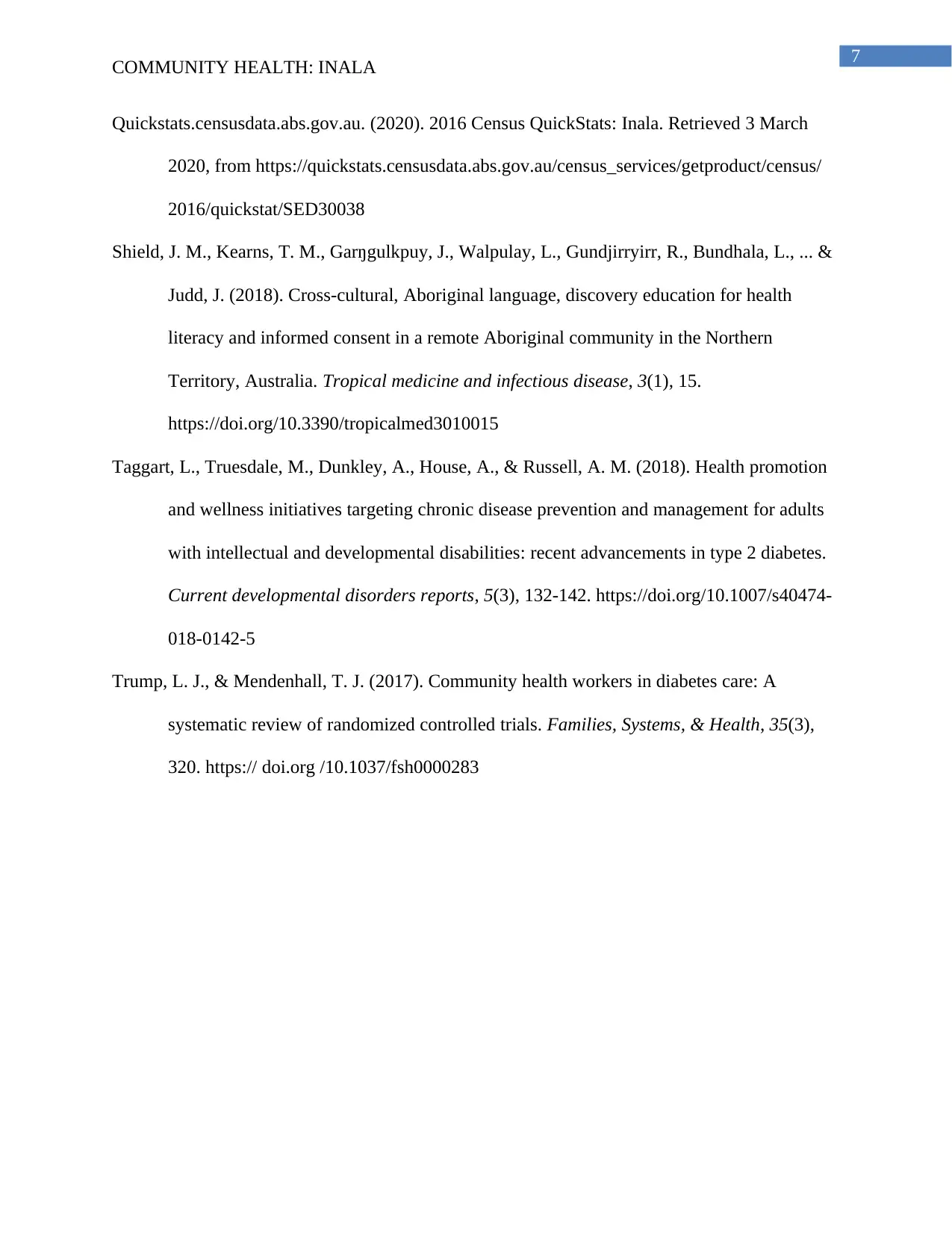
7
COMMUNITY HEALTH: INALA
Quickstats.censusdata.abs.gov.au. (2020). 2016 Census QuickStats: Inala. Retrieved 3 March
2020, from https://quickstats.censusdata.abs.gov.au/census_services/getproduct/census/
2016/quickstat/SED30038
Shield, J. M., Kearns, T. M., Garŋgulkpuy, J., Walpulay, L., Gundjirryirr, R., Bundhala, L., ... &
Judd, J. (2018). Cross-cultural, Aboriginal language, discovery education for health
literacy and informed consent in a remote Aboriginal community in the Northern
Territory, Australia. Tropical medicine and infectious disease, 3(1), 15.
https://doi.org/10.3390/tropicalmed3010015
Taggart, L., Truesdale, M., Dunkley, A., House, A., & Russell, A. M. (2018). Health promotion
and wellness initiatives targeting chronic disease prevention and management for adults
with intellectual and developmental disabilities: recent advancements in type 2 diabetes.
Current developmental disorders reports, 5(3), 132-142. https://doi.org/10.1007/s40474-
018-0142-5
Trump, L. J., & Mendenhall, T. J. (2017). Community health workers in diabetes care: A
systematic review of randomized controlled trials. Families, Systems, & Health, 35(3),
320. https:// doi.org /10.1037/fsh0000283
COMMUNITY HEALTH: INALA
Quickstats.censusdata.abs.gov.au. (2020). 2016 Census QuickStats: Inala. Retrieved 3 March
2020, from https://quickstats.censusdata.abs.gov.au/census_services/getproduct/census/
2016/quickstat/SED30038
Shield, J. M., Kearns, T. M., Garŋgulkpuy, J., Walpulay, L., Gundjirryirr, R., Bundhala, L., ... &
Judd, J. (2018). Cross-cultural, Aboriginal language, discovery education for health
literacy and informed consent in a remote Aboriginal community in the Northern
Territory, Australia. Tropical medicine and infectious disease, 3(1), 15.
https://doi.org/10.3390/tropicalmed3010015
Taggart, L., Truesdale, M., Dunkley, A., House, A., & Russell, A. M. (2018). Health promotion
and wellness initiatives targeting chronic disease prevention and management for adults
with intellectual and developmental disabilities: recent advancements in type 2 diabetes.
Current developmental disorders reports, 5(3), 132-142. https://doi.org/10.1007/s40474-
018-0142-5
Trump, L. J., & Mendenhall, T. J. (2017). Community health workers in diabetes care: A
systematic review of randomized controlled trials. Families, Systems, & Health, 35(3),
320. https:// doi.org /10.1037/fsh0000283

8
COMMUNITY HEALTH: INALA
COMMUNITY HEALTH: INALA
⊘ This is a preview!⊘
Do you want full access?
Subscribe today to unlock all pages.

Trusted by 1+ million students worldwide
1 out of 9
Related Documents
Your All-in-One AI-Powered Toolkit for Academic Success.
+13062052269
info@desklib.com
Available 24*7 on WhatsApp / Email
![[object Object]](/_next/static/media/star-bottom.7253800d.svg)
Unlock your academic potential
Copyright © 2020–2025 A2Z Services. All Rights Reserved. Developed and managed by ZUCOL.





